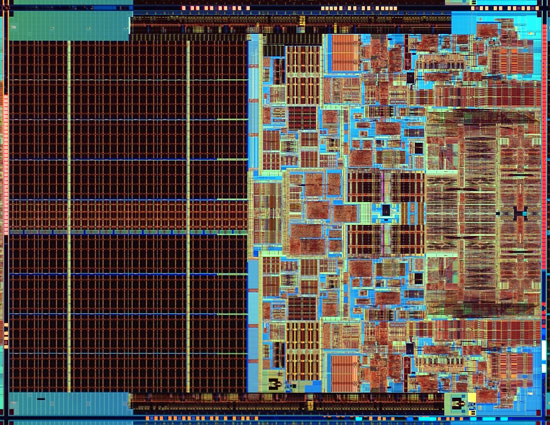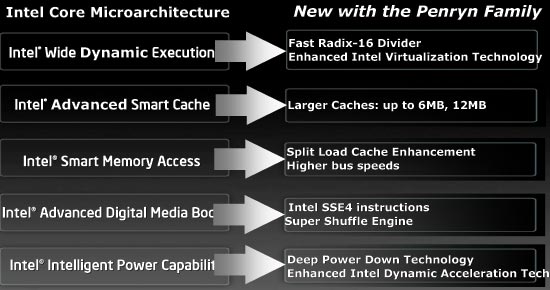The Penryn Preview - Part I: Wolfdale Performance
by Anand Lal Shimpi on August 21, 2007 12:35 PM EST- Posted in
- CPUs
By the end of this year, AMD will introduce Phenom and Intel will introduce Penryn - its first 45nm desktop CPU.
For a while there we wondered how Intel would introduce Penryn into its lineup, but as of Intel's last roadmap update we now know. On top of that, we managed to get our hands on a dual-core Penryn so now we know exactly how fast the new core is going to be. Combine the two datapoints and there's a wealth of knowledge to share. So gather 'round the fire, it's time to benchmark CPUs.
Recapping Penryn
Penryn is more than just a die-shrunk Conroe, but it isn't anywhere near as revolutionary as what Conroe was to its predecessor. The Conroe-Penryn evolution is one cycle of Intel's tick-tock model, Penryn's successor (Nehalem) will be the next revolutionary core you see out of Intel (at least that's what we're expecting).

Penryn is built on Intel's 45nm process, thus dropping power consumption increasing switching speed and allowing Intel to cram more transistors on a die (107mm^2 for dual-core Penryn vs. 143mm^2 for Conroe).

A dual-core Penryn die

A dual-core Conroe die
Intel lists the following 9 enhancements as what's new in the Penryn family:

The faster divider and super shuffle engine will increase performance in very specific applications and won't be broad increasers of performance. The larger caches obviously will increase performance, but prior to today we weren't sure by how much.
SSE4 support can bring about tremendous performance improvements, but it requires software optimization. In our initial Penryn Preview we reported an over 100% increase in performance in SSE4 optimized DivX encoding for a quad-core Penryn at 3.33GHz vs. a quad-core Kentsfield at 2.93GHz.
We detailed all of the Penryn enhancements and the markets they impact in our original Penryn article. Keep in mind that things like Penryn's Deep Power Down Technology and higher bus speeds may not apply to all Penryn cores (the former is only in Mobile Penryn while the latter will appear on servers first).
Never Take Sides Against the Family
Penryn is the overall family name but there are two cores in particular that we'll be talking about today: Wolfdale and Yorkfield.
Wolfdale is a dual-core desktop Penryn core with a 6MB L2 cache shared between the two cores. Yorkfield is two Wolfdales on the same package, giving the quad-core CPU a total of 12MB of L2 cache.
Wolfdale and Yorkfield are architecturally identical, so performance per core is no different between the processors - Yorkfield simply has more cores.










55 Comments
View All Comments
OddTSi - Tuesday, August 21, 2007 - link
Exactly. As I was scrolling down that overclocking page I actually expected them to show what they did (how high it goes without a voltage bump) and then to cap it off at the very bottom with a "oh, here's the absolute highest we could get it to" screen shot.Go back in the lab Anand, stick the biggest HSF you've got on there and crank it up until it can't go up anymore and tell us what you got it to. ;)
gigahertz20 - Tuesday, August 21, 2007 - link
Anand has been slacking, first in the Q6600 GO article he forgets to mention what HSF he used and now he forgets or didn't want to raise the stock core voltage to see what the maximum overclock is? Bahhhhhh, I nominate all articles to either be written by Wesley Fink, Gark Key, Jarred Walton, or Derek Wilson.NullSubroutine - Tuesday, August 21, 2007 - link
I would like to see such benchmarks as well, if you have the time constraints to do so.It would be interesting to compare 3.33 C vs 3.33 P to see what kind of scaling difference there is between the two. And just overall max clock with volt increase you could get with revision A0 (with benchmarks) it would be a good performance preview for a ways down the road.
retrospooty - Tuesday, August 21, 2007 - link
"It would be interesting to compare 3.33 C vs 3.33 P to see what kind of scaling difference there is between the two. And just overall max clock with volt increase you could get with revision A0 (with benchmarks) it would be a good performance preview for a ways down the road"I second that. Hopefully the next review has what we all came to see = )
Seriously though. since the cache has improvements, and is also larger, we may well see it scale better. In other words its an avg of 5% faster at a meager 2.33 ghz, but what about 3.5, or higher which I am sure could be achieved by raising voltage. It may be quite a bit more.
Hippiekiller - Tuesday, August 21, 2007 - link
Im almost glad (almost) to see that the performance difference isnt that great. It would be interesting to see each company have similar performing parts.My question is would similar performance lead to an even more aggressive price war then the one we have seen recently? Or, would each company just stop at a relatively higher price then we currently see, not willing to slash unless it has to in order to counter the others move.
Spoelie - Tuesday, August 21, 2007 - link
You're not taking into consideration the higher clock speeds penryn will undoubtly have, which moves the performance delta up a bit more than the 5% at the, most likely, equal pricepoints of conroe chips.FujiT - Tuesday, August 21, 2007 - link
ok, Penryn is a die shrink with some tweaks. The average boost is 5% and that's not including the boost from SSE4 which pretty much results in a 100% boost in performance.And the retail Penryns will probably overclock better. The initial stepping supposedly had some problems reaching the high clock speeds that Intel promised, but it's been said that the new stepping solved that problem.
With Penryn, the performance boost not only comes out from the IPC increase, but the performance in clock speed. It's supposed to top out at 4 GHz (according to Intel) and Nehalem is supposed to pick up where Penryn left off clock speed wise.
duploxxx - Wednesday, August 22, 2007 - link
the IPC performance increase is minimal, when a program likes more cache it is faster, if not it is the same. these benches from anand show it.we'll see how far it will go with penryn and GHZ, in Q1 2007 they were not sure if they were able to fit the 3,33GHZ into a 120W TDP !!!!
About you're future... if it said by intel then leave it here out of the comments to ne you are just a fanboy, Nehalem is still vaporware and you guys are already hyping it... memorycontroller and fast huge on die caches do not work together....!!!!!
@anand, what was the stepping of you're conroe versus wolfdale.
fitten - Thursday, August 23, 2007 - link
Why do you say that?
GhandiInstinct - Tuesday, August 21, 2007 - link
I love having an answer to the #1 question in my head for months.
Thank you AnandTech!